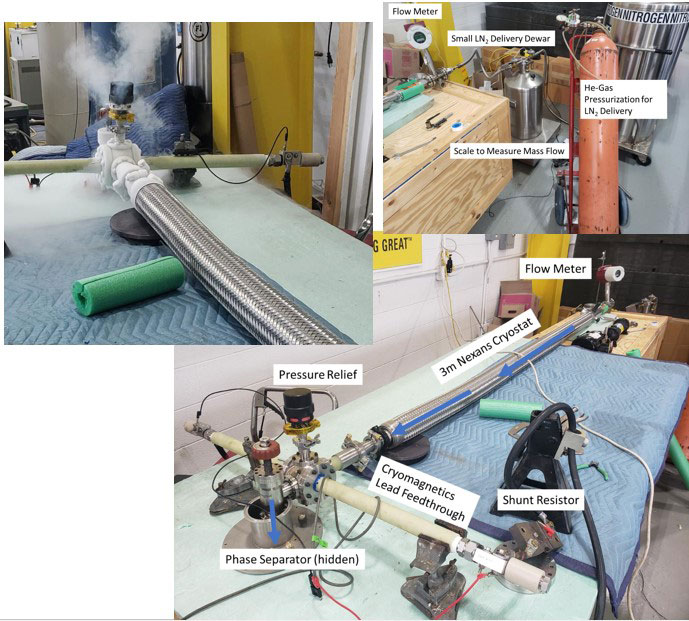AP-2-4
NASA CHEETA Cryogenic Electrical Cables and Terminations
14:45-15:00 28/11/2023
Christopher J. Kovacs1, *Timothy J. Haugan2, Michael D. Sumption3, Phillip J. Ansell4
1. Scintillating Solutions LLC, Columbus, Ohio, USA
2. Aerospace Systems Directorate, Air Force Research Laboratory, Wright-Patterson AFB, Dayton, Ohio, USA
3. Department of Materials Science and Engineering, The Ohio State University, Columbus, Ohio, USA
4. Department of Aerospace Engineering, University of Illinois at Urbana-Champaign, Champaign, Illinois, USA
Single aisle and twin aisle large commercial aircraft presently contribute approximately 1.9 to 2.3% of global CO2 emissions. While this appears to be a small portion, it is projected this will grow in coming decades and decreasing global greenhouse gas emissions will require a many pronged approach. Of the many initiatives and programs to develop remarkably high efficiency commercial aircraft by 2035, a later generation NASA N+3 aircraft will require roughly 45 MW of electrical power. At powers this high, nearly every electrical component will require significant breakthroughs in light weighting and performance. As part of a NASA program to develop, mature, and design disruptive technologies for electric single isle commercial aviation, The Center for Cryogenic High-Efficiency Electrical Technologies for Aircraft (CHEETA) is developing a LH2 fueled aircraft. The CHEETA aircraft will operate with lower voltages (±270 VDC) and the LH2 fuel permits the use of cryogenically cooled components and can supply substantial cryogenic and non-cryogenic cooling for other systems.
In the CHEETA aircraft, the transmission cables of the electrical wiring and interconnection system (EWIS) can start to weigh 1000s of kg, which is why alternate conductors including high ampacity ultrahigh purity Al at 20 K, and high critical current high temperature superconducting (HTS) cables including MgB2, barium strontium calcium copper oxide (BSSCO), and rare-earth barium copper oxide (REBCO) are being examined. Ultrahigh purity Al cables are options which can be extremely lightweight, however they still have resistive Joule losses which would have to be managed with cryogenic liquids. Because of the challenges foreseen and unforeseen, it will be important to conduct ground based EWIS demonstrations. For cost saving measures, the demonstration system would have to be versatile enough to examine different cables, terminations, and other components without substantial modifications. In this contribution, we will present studies associated with developing the cables and terminations within the EWIS for the CHEETA aircraft.
1. M. P. Sebastian, T. J. Haugan, and C. J. Kovacs, “Design and Scaling Lawas of a 40-MW Class Electric Power Distribution System for Liquid-H2 Fuel-Cell Propulstion”, AIAA Propulsion and Energy Forum (2021)
2. D. C. van der Laan, C. H. Kim, S. V. Pamidi, and J. D. Weiss, “A Turnkey Gaseous Helium-Cooled Superconducting CORC DC Power Cable with Integrated Current Leads”, SUST (2022)
3. C. J. Kovacs, T. J. Haugan, and M. D. Sumption, “Metal Composite T-Junction Terminals for MW-Class Aerospace Electric Power Distribution”, ISS 2020 (2021)
4. P. Kovac et al., “MgB2 Cables Made of Thin Wires Manufactured by IMD Process”, SUST (2020)
5. S. Yamaguchi and M. Kanda, "A Proposal for a Lightweight, Large Current Superconducting Cable for Aviation", SUST (2021)
6. C. J. Kovacs, T. J. Bullard, T. J. Haugan, and M. D. Sumption, “Cryogenic Electrical Properties of an Aluminum-Beryllium Nanocomposite”, IEEE Trans. Appl. Supercon. (2023)
We would like to acknowledge support by NASA University Learning Initiative (ULI) #80NSSC19M0125
